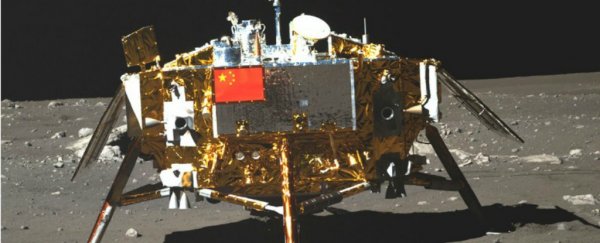Chinese researchers have reported that a small, robotic telescope they landed on the Moon back in 2013 has been working flawlessly this whole time. And although this is the first many of us are hearing about the device, it's pretty exciting news, because the telescope's been able to observe all kinds of things that aren't possible to see through Earth's big, thick atmosphere.
"There is no atmosphere on the Moon, so unlike Earth, the ultraviolet light from celestial objects can be detected on the Moon," Jing Wang from the National Astronomical Observatories in Beijing told New Scientist.
The Moon also rotates a lot slower than Earth - roughly 27 times slower, to be precise - which means that the telescope is also able to look at the same star for days at a time, something that's impossible here on Earth.
The 15-centimetre telescope is the first robot telescope to operate on the Moon's surface, and you don't have to be too worried about it spying on you, because it's only built to detect ultraviolet light.
So far since landing on the Moon, it's been able to make 2,000 hours of observations, including monitoring of 40 stars, and even captured this pretty image of the Pinwheel Galaxy, which is 21 million light-years away.
 National Astronomical Observatories
National Astronomical Observatories
The researchers have now reported the results from the first 18 months of the telescope's mission in arXiv.
While this isn't the first telescope to be used on the Moon - that honour goes to a manual telescope used during the Apollo 16 mission - the fact that it's a robotic device makes it a lot more challenging to keep operational.
In fact, the telescope was predicted to have a lifespan of no longer than one year when it first landed, which is why it's such a surprise that it's been going strong for almost two years now.
The telescope arrived on the Moon with the Chang'e 3 lander, which carried the Chinese Yutu rover, also known as the Jade Rabbit, in December 2013. The rover since hasn't faired so well, after struggling to survive the days-long lunar nights, and it finally stopped transmitting data in March this year.
But the Chinese telescope has done a lot better. In order to survive the hostile lunar dust, which can destroy electronics, the device is stowed safely inside the Chang'e 3 lander during sunrise and sunset, which is believed to be the harshest time of day.
As Jacob Aron reports for New Scientist, the team is now considering whether to keep the telescope mission running past the end of 2015. If the observations so far are anything to go by, we hope it stays in business. After all, it's been a long time since we've been able to enjoy the vantage point of the Moon. Next step? Telescopes on Mars.
